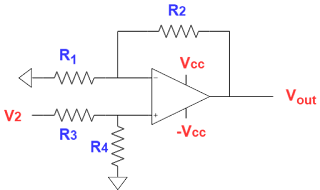FINDING GAIN OF DEGENERATED & CASCODE AMPLIFIER
In this post, we shall discuss two basic amplifiers.
Q1) Find the gain.
Solution:
From the signal flow, it is evident that the amplifier is in CS
mode.
$GAIN=V_{IN} \times \frac{R_{LOAD}}{R_{LOAD}+R_{OUT}}$
Now, ${R_{LOAD}=R_{D}}$ ; ${R_{OUT}=r_{0}+M \times R_{S}}$, where $M=
1+g_{m}r_{0}$
How did I write the above expression?
Go check.
$GAIN= -g_{m}r_{0} \times \frac {R_{D}}{R_{D}+(r_{0}+M \times R_{S})}
\approx -g_{m}r_{0}\times \frac {R_{D}}{M \times R_{S}} \approx
-\frac{R_{D}}{R_{S}}$
Let's try to solve it by another method called, $G_{m}r_{out}$ method and
match the results with the above result.
Another Method:
We know the equivalent transconductance of the source-degenerated CS is
$G_{M}= - \frac {g_{m}}{1+g_{m}R_{S}}$
$R_{eq}=R_{LOAD} || R_{OUT} \approx R_{D}$
$GAIN=G_{M}R_{eq}=- \frac {g_{m}}{1+g_{m}R_{S}} \times R_{S}$
Considering, $g_{m}R_{S}>>1$
$GAIN \approx -\frac{R_D}{R_S}$, which matches with the previous
result.
Q2) Find the gain.
Solution: Let's draw the schematic for a small signal.
The above diagram shows that M1 and M2 are in CS and CG mode
respectively.
$GAIN= -g_{m1}r_{01} \times M_{2} \times \frac
{R_{LOAD}}{R_{LOAD}+R_{OUT}}$
where, $R_{LOAD}= r_{03}+M_3 \times r_{04} \approx M_3 \times
r_{04}$
$R_{OUT}= r_{02}+M_2 \times
r_{01} \approx M_2 \times r_{01}$
Now,
The $GAIN= -g_{m1} \times \frac {M_{2} \times r_{01} \times
R_{LOAD}}{R_{LOAD}+R_{OUT}}$ =$-g_{m1}(R_{LOAD}|| R_{OUT})$
Let's also try with $G_{m}r_{out}$ method.
Another Method:
$\frac{I_{SC}}{V_{IN}}= G_{M}=-g_{m1} \frac
{r_{01}}{\frac{1}{g_{m2}}+r_{01}} \approx -g_{m1}$
$GAIN=G_MR_{eq}=-g_m \left(R_{LOAD}||R_{OUT} \right)$, which matches with
above result.
We will solve more complex circuits in the upcoming posts.
Check previous posts of the series we started "INTRINSIC GAIN
METHOD".
PART2: INTRINSIC GAIN METHOD PARAMETERS
PART3: FINDING EQUIVALENT IMPEDANCE
For part 5 follow our blog and don't forget to comment


.png)
































